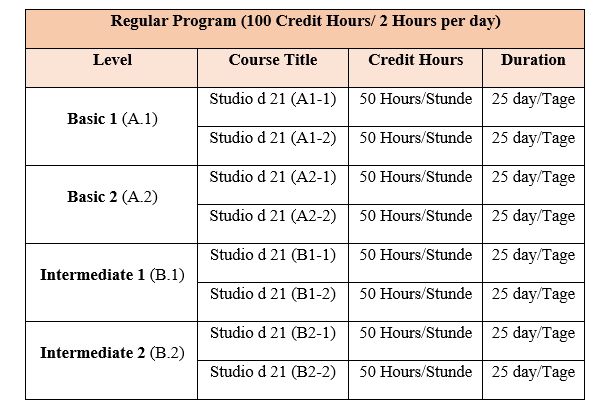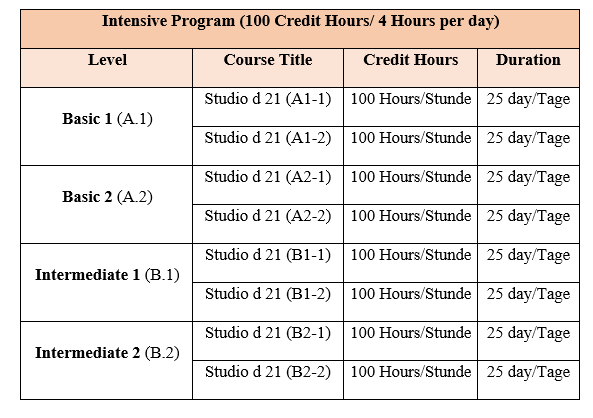German Language Unit
The German language holds significant importance among foreign languages. It is renowned for its contributions to modern philosophy, criticism, and literature. German language education in Yemen began with the establishment of the German Language Department at the Faculty of Languages in 2003 and the German Language Unit at the CCTLT in the academic year 2014/2015. It is the predominant mother tongue within the European Union and is spoken in many countries around the world. As part of the Indo-European language family, German is classified among approximately 15 Germanic languages. With around 130 million speakers across Germany, Austria, Switzerland, Luxembourg, Belgium, Liechtenstein, South Tyrol in Italy, and other regions, it stands as the 11th most spoken language worldwide. According to a study entitled “German as a Foreign Language in the World,” published in 2020, approximately 15.54 million individuals are presently engaged in learning German as a foreign language.
Interest in learning German is increasing significantly in many countries, driven by several factors, including the robust German economy, which enhances the people’s appeal to learning German. Moreover, the German government has implemented an effective policy to reinforce the dissemination of its language and culture. This involves substantial support for educational institutions domestically and internationally, facilitating educational and scholarship programs, and extending study opportunities to international students. Such initiatives justify the escalating interest in the German language, notably in Asian and African countries, with Yemen standing out as a significant example.
The German government also supports the professional development of German language educators through specialized initiatives implemented by intermediary organizations such as the German Academic Exchange Service (DAAD) scholarship programs and the “Learn German Teaching” program administered by the Goethe Institute, which conducts proficiency exams in the German language. Recent statistics reveal a substantial rise in participation, with nearly 309,000 students enrolled in German language courses and examinations, marking a significant surge compared to figures from five years ago. Statisticians attribute this increase and growing interest in linguistic qualification among skilled and specialized individuals to the German Skilled Worker Migration Law, enacted in 2020, which streamlines the migration process for skilled workers from non-EU nations to Germany.
The German Language Unit offers the following courses in the German Proficiency Program:
Regular Program
Intensive Program
The Unit Aims
The German Language Unit aims to achieve the following objectives:
Providing students with the required skills to use German language in different contexts.
Teaching German language skills for communication purposes in both writing and speaking.
Teaching German language skills for academic purposes.
Introducing students to German culture, ways of life, history, and philosophy.
Providing German language tests for various purposes.
Teaching German language skills for translators.
Offering tutors training programs in the German language in Teaching Methods and assessment.
German Proficiency Program
Importance of the Program
The importance of the program stems from the global prominence of the German language. German ranks among the most commonly spoken languages in Europe and is the third most studied foreign language worldwide, holding the second position in popularity within Europe and Japan. Germany boasts the third-largest economy globally and stands as the foremost exporter, making Germany a highly advantageous choice for those seeking employment, business ventures, or tourism opportunities. Furthermore, the German government offers numerous scholarships through cultural exchange initiatives across diverse fields and domains, mandating proficiency in the German language for study and residency eligibility.
Program Aims
Introducing students to the basics of the German language, starting from alphabets, vocabulary, and sentences.
Providing students with a solid understanding of German grammar and writing conventions.
Empowering students with the skill to effectively use German to introduce themselves and communicate in diverse situations and contexts.
Equipping students with the vocabulary and linguistic structures needed for everyday activities and specific specialized domains.
Enhancing students’ reading skills and comprehension of everyday dialogues.
Program Features
The program was developed in accordance with local accreditation standards and the Common European Framework of Reference for Languages (CEFR).
It has experienced and highly qualified tutors.
Its curriculum features the most recent series of German language with accompanying resources, teaching aids, and illustrations.
It awards students with recognized certificates from Sana’a University.
It offers a motivating learning environment with modern educational resources and using modern technology.
Target Groups
Students aspiring to pursue studies at German universities or institutes.
Individuals from diverse backgrounds seeking to learn German for career-related purposes.
Individuals intending to travel to Germany or other German-speaking regions for purposes such as residency, medical care, business or tourism.
Translators.
Individuals interested in delving into the German language, culture, traditions, and arts.
Program Study Plan
A. Regular Program

B. Intensive Program

